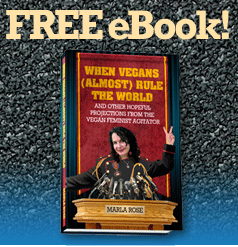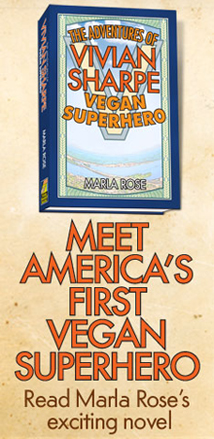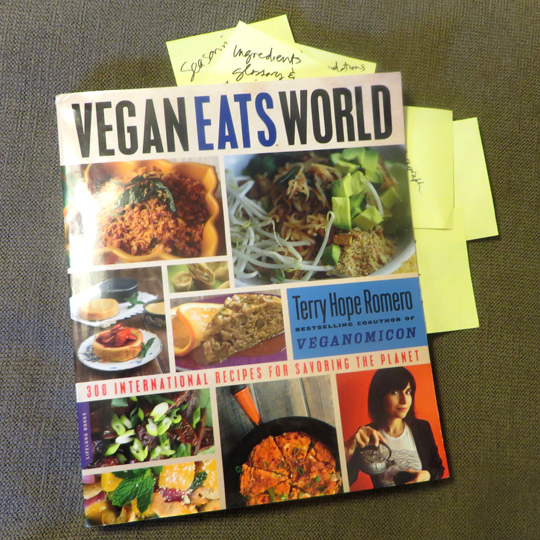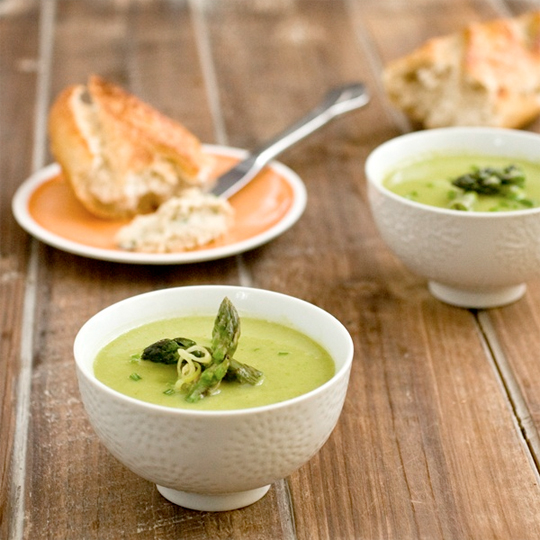
If you would prefer a printed softbound version of When Vegans (Almost) Rule the World, you can pick one up for just $11.99 at Amazon. Kindle eBook coming soon!

Available in either softbound or Kindle/Nook/etc. eBook at Amazon
viviansharpe.com

  Book Review: Vegan Eats World by Terry Hope Romero review by Marla Rose In the introduction to the new soft-cover edition of beloved cookbook author Terry Hope Romero’s Vegan Eats World: 300 International Recipes for Savoring the Planet, she asks a simple but thought-provoking question: “What if the world was vegan?” In her vivid, passionate response to this question, we get an answer: it would be full of full-flavored, rich, aromatic, spicy, sweet and delightful foods from around the world, as uncompromising in taste as it is in ethics. In her introduction - really, one of the most best I’ve read - Ms. Romero lays out her cooking philosophy in eloquent detail, creating as much as a case for sanity about food as a spirited, deeply personal ode to the voluptuous, diverse and quirky flavors and textures of international cuisine. Can an unapologetic sensualist have her cake and not compromise her deeper values? It turns out, yes, absolutely. “This is the story, in the form of a rather heavy little cookbook, of a vegan history that has never existed but is alive today, inspired by all the great cuisines that ever were,” she writes. “Many of these foods already go into wholesome vegan meals. The hummus you smeared on a breakfast bagel, the falafel pita stuffed with roasted eggplant downed for lunch between classes, the red curry tofu shared with a friend for dinner, a seitan taco devoured from a forward-thinking food truck, a weekend family meal gathered around homemade potato pierogi. All of these foods didn’t just imagine themselves into being; they started their lives elsewhere on a part of the planet likely very different from the one you’re probably reading this paragraph right now.” Written from Ms. Romero’s multicultural vantage point in Queens, New York City, a place where an astonishing array of ethnic diversity intermingles, she has access to not only the myriad cuisines but the ingredients. While not everyone has access to such cultural variety, Ms. Romero offers her “vision for a new cuisine without borders” and I am happy to see that most recipes can be created with just a well-stocked grocery store in town, and alternatives for rarer ingredients are almost always provided. As the author and co-author of many treasured cookbooks, she knows how to construct and write a recipe. Starting out with a really helpful section called “Kitchen Cartography” with tons of very useful bits of guidance on everything from cooking terms to an ethnic ingredients glossary, this is a book that anyone could find useful. With sidebars throughout on topics such as how to sauté with less or no oil and seasoning a wok, and helpful icons designating everything on recipes from less expensive to relative ease, this is a user-friendly cookbook and also excellent for anyone who wants to step up their kitchen skills game a notch or two. Now, on to the actual recipes: friends, this is the motherlode of vegan ethnic cuisine at your fingertips. With chapters ranging from Spice Blends and Pickles, Chutneys & Saucier Sauces to Dumplings, Breads & Pancakes to Robust Vegetable Entrees & Sides, no corner of the taste buds or the globe is left unexplored. Tangy, sweet, spicy, sour as well as soft and crunchy, it’s all here, and it comes with the Preserved Lemons of the Middle East (two recipes, in fact, a quick and a slow version) to the Colombian Coconut Lentil Rice, and every delicious land in between. With vivid descriptions, helpful shortcuts, tips and substitution suggestions, the recipes are made that much easier. While the author is a clear fan of recipes with lots of ingredients, most of these are inexpensive items, and the recipes themselves, while often long, do not generally require a lot of work: most of these dishes are earthy classics from around the globe. Having a grocery store near you that sells spices in bulk is especially handy with this cookbook. I also appreciate that even if something is less than traditional, such as including berbere spices in a flourless chocolate torte or avocado and spicy greens in familiar Pad Thai, she doesn’t allow her imagination and love of food to be reined in by a slavish devotion to authenticity. After all, these are vegan interpretations of dishes that often include animals. Why not have fun as we recreate them? Beautifully and thoughtfully presented, Vegan Eats World is laid out with clear, colorful art direction and quite a few photographs. From start to finish, it really is an accomplishment that people will enjoy for years to come and I believe that we will look back at it as a classic in the pantheon of vegan cookbooks. This is my kind of cookbook and I highly recommend it. Thank you to Da Capo Lifelong for permission to reprint French Farmhouse Asparagus Bisque. With asparagus season still in swing, now is a great time to try this sophisticated recipe. From Vegan Eats World by Terry Hope Romero. Reprinted with permission from Da Capo Lifelong, ©2014.  French Farmhouse Asparagus Bisque 1 pound asparagus 1 large leek (about 1 pound) 1 tablespoon plus one teaspoon olive oil 1/2 cup dry white wine 4 cups vegetable broth 1 pound white baking potato, peeled and diced into 1/2-inch-thick pieces 6 sprigs fresh thyme or 1/2 teaspoon dried thyme 1/2 teaspoon salt or to taste 1/4 cup plain soy or coconut-based creamer 2 tablespoons finely chopped fresh chives, plus one more tablespoon for garnish 1. Wash the asparagus and trim away the bottom 1/2-inch from the stalks. Slice off and set aside the tips, and dice the stalks into 1/2-inch pieces. Trim the roots from the leek, then trim away the top 4 inches from the green leaves at the other end. Slice the leek in half and run under cold water, gently pushing apart the leaves to rinse away any grit. When leek is clean, slice it into slices 1/4-inch thick. 2. In a medium soup pot, heat 1 tablespoon of the oil over medium heat and sauté the leek for 3 minutes or until it begins to soften. Add the chopped asparagus stalks and sauté for 4 minutes, stir in the wine and simmer for 2 minutes. Stir in the vegetable broth, potatoes, and thyme. Increase the heat to high, bring to an active simmer for 1 minute, then reduce heat to medium-low. Cover and simmer for 22 to 24 minutes until the potatoes are very tender and mash easily when pressed with a fork. 3. While the soup is cooking, over medium heat in a small skillet, sauté the asparagus tips with the remaining 1 teaspoon of olive oil for 1 to 1 1/2 minutes or until the tips are bright green and crisp tender. Transfer the tips to a dish and sprinkle with a pinch of sea salt. 4. Turn off the heat and remove the thyme sprigs if using. Add the soy or coconut-based creamer. Use either a potato masher and mash the soup to a chunky purée, or insert an immersion blender into the soup and puree into the smoothest soup possible; take your time to ensure that the soup gets very smooth. Stir in the chopped shives and salt, then taste the soup and season with more salt to taste if necessary. To serve, ladle soup into wide serving bowls and garnish each serving with a few sautéed asparagus tips and a pinch of chopped chives. Author note: The white stem ends of older asparagus can be filled with tough fibers. Out of season asparagus thicker than 1/2-inch should be trimmed by at least 1 inch from the bottom stem. © 2013, 2014, Vegan Street |













 |
 |
 |
 |
 |
 |
 |